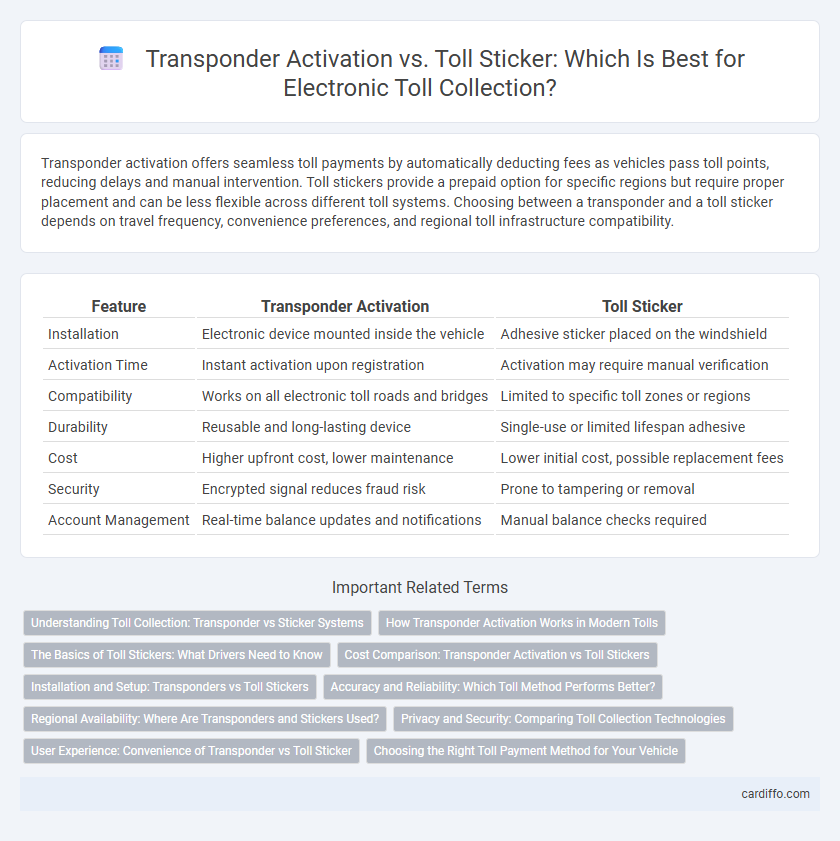Transponder activation offers seamless toll payments by automatically deducting fees as vehicles pass toll points, reducing delays and manual intervention. Toll stickers provide a prepaid option for specific regions but require proper placement and can be less flexible across different toll systems. Choosing between a transponder and a toll sticker depends on travel frequency, convenience preferences, and regional toll infrastructure compatibility.
Table of Comparison
| Feature | Transponder Activation | Toll Sticker |
|---|---|---|
| Installation | Electronic device mounted inside the vehicle | Adhesive sticker placed on the windshield |
| Activation Time | Instant activation upon registration | Activation may require manual verification |
| Compatibility | Works on all electronic toll roads and bridges | Limited to specific toll zones or regions |
| Durability | Reusable and long-lasting device | Single-use or limited lifespan adhesive |
| Cost | Higher upfront cost, lower maintenance | Lower initial cost, possible replacement fees |
| Security | Encrypted signal reduces fraud risk | Prone to tampering or removal |
| Account Management | Real-time balance updates and notifications | Manual balance checks required |
Understanding Toll Collection: Transponder vs Sticker Systems
Transponder activation enables seamless toll collection by using wireless communication between the vehicle-mounted device and toll gantries, providing real-time data processing and automatic account deduction. Toll stickers, or vignettes, require pre-purchase and visible display on the windshield, serving as proof of toll payment for a specific period or region but lack real-time validation. Transponders offer greater convenience and flexibility for frequent travelers, while stickers simplify toll compliance for occasional users or in areas without electronic toll infrastructure.
How Transponder Activation Works in Modern Tolls
Transponder activation in modern toll systems relies on radio-frequency identification (RFID) technology to enable seamless, contactless toll payments. Vehicles equipped with a transponder communicate with toll gantries, automatically deducting toll fees from linked accounts without stopping. This method enhances traffic flow and reduces congestion compared to toll stickers, which require visual inspection and physical placement on the windshield.
The Basics of Toll Stickers: What Drivers Need to Know
Toll stickers, also known as vignettes, offer a simple, prepaid method for drivers to use toll roads without the need for electronic devices. These stickers must be visibly displayed on the windshield and are valid for a specific duration or vehicle category, ensuring compliance with regional toll regulations. Unlike transponder activation, which requires a linked account and electronic detection, toll stickers provide a hassle-free alternative for short-term or occasional road users.
Cost Comparison: Transponder Activation vs Toll Stickers
Transponder activation typically involves an upfront fee ranging from $10 to $40 plus a monthly service charge of $3 to $7, while toll stickers usually require a one-time purchase between $20 and $50 without recurring fees. Transponders often provide discounted toll rates compared to the standard charges incurred with toll stickers, leading to potential savings for frequent travelers. Cost-effectiveness depends on travel frequency; occasional users may benefit more from the low initial cost of stickers, whereas regular commuters save over time with transponder discounts.
Installation and Setup: Transponders vs Toll Stickers
Transponder installation involves mounting a small electronic device on the windshield, which requires minimal setup and communicates automatically with toll systems for seamless payment. Toll stickers, often adhesive tags, are simpler to apply but usually require proper placement on the vehicle and manual activation through an online portal. Both methods demand precise installation to ensure accurate toll detection, but transponders generally offer faster, hassle-free setup and real-time account management.
Accuracy and Reliability: Which Toll Method Performs Better?
Transponders provide superior accuracy and reliability in toll collection by using radio-frequency identification (RFID) technology to ensure precise vehicle identification and seamless transactions. Toll stickers, while convenient, may suffer from wear and tear or improper placement, leading to reading errors and potential delays. Overall, transponders outperform toll stickers in delivering consistent and accurate toll processing across multiple toll points.
Regional Availability: Where Are Transponders and Stickers Used?
Transponders are predominantly used in North America, Europe, and parts of Australia where electronic toll collection systems are widespread, enabling seamless, automated toll payments. Toll stickers, commonly referred to as vignettes, are primarily found in Central and Eastern Europe and several countries in the Middle East, allowing drivers to prepay tolls for fixed periods on highways. Regional availability differences stem from infrastructure investments and tolling system preferences, with transponders favored in heavily trafficked urban areas and stickers in regions prioritizing simplicity.
Privacy and Security: Comparing Toll Collection Technologies
Transponder activation for toll collection enhances privacy by using encrypted signals that minimize data exposure during transactions, whereas toll stickers often store static information that can be more easily tracked or duplicated. Advanced transponder systems incorporate secure authentication protocols, reducing the risk of fraud and unauthorized access compared to passive toll stickers. This technology shift prioritizes user privacy and data security, making transponders a superior choice for confidential toll processing.
User Experience: Convenience of Transponder vs Toll Sticker
Transponder activation offers seamless toll payments by enabling automatic detection without the need for manual interaction, enhancing user convenience through real-time processing. Toll stickers require physical application and manual renewal, potentially causing delays and inconvenience during travel. The transponder's easy setup and efficient toll passage significantly improve user experience compared to the fixed and less flexible toll sticker system.
Choosing the Right Toll Payment Method for Your Vehicle
Choosing the right toll payment method depends on your vehicle type, travel frequency, and regional toll system compatibility. Transponder activation offers seamless electronic toll collection, ideal for frequent travelers seeking convenience and discounts across multiple toll roads. Toll stickers provide a prepaid, fixed-duration pass suitable for occasional users or specific regions with sticker-based toll enforcement.
Transponder Activation vs Toll Sticker Infographic

 cardiffo.com
cardiffo.com